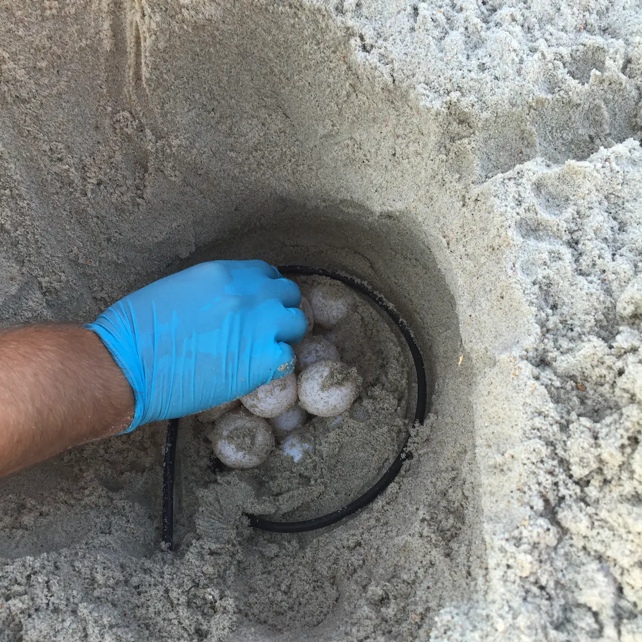Playing with my children on a beach on Hatteras Island, a barrier island off the coast of North Carolina, I struck up a conversation with a man walking his dog.
We were standing next to a turtle nest, which the National Park Service had roped off with a sign stating that the spot was federally protected.
"Wouldn't it be nice to know exactly when the baby sea turtles will come out?" I mused. He smiled and said, "Well, we're working on that."
That conversation generated a partnership to develop TurtleSense, a novel, inexpensive way to monitor turtle nest activity remotely. In a newly published study, we describe how it works.
Participants included Eric Kaplan, the man I met on the beach and the founder of the Hatteras Island Ocean Center; David Hermeyer and Samuel Wantman, retired engineers at the San Francisco nonprofit Nerds Without Borders; IBM master inventor Thomas Zimmerman; and veterinary student Joshua Chamberlin.
As a developmental neuroscientist, I worked to understand how the baby turtles might use motion or vibrations to coordinate nest activity.
Humans can best protect sea turtle hatchlings as they make their way from the beach to the sea if they know precisely when the baby turtles will appear. But predicting emergence has been difficult.
We found that by placing a simple sensor disguised as a turtle egg in the nest, we could detect activity in the nest that indicated when the baby turtles would emerge from the sand and swarm toward the water.
A hazardous journey
Sea turtles spend their lives in the ocean, except when females come ashore a few times each summer to lay their eggs. Once they lay their eggs and bury them in the sand, they return to the water.

The eggs incubate beneath the sand for several weeks. Then the hatchlings erupt up out of the sand, usually as a massive sibling group, and scramble toward the surf. This journey is a highly vulnerable moment in a sea turtle's life.
Hatchlings must avoid beach debris, as well as birds and crabs waiting to prey on them. They also may become disoriented because of light pollution from beach houses and hotels and fail to reach the water, dying of dehydration on the sand.
All six species of sea turtles found in the US are protected under the Endangered Species Act, so beach communities are required to ensure that baby turtles receive proper protection – including on their journey to the water.
Scientists typically guess at emergence dates based on the amount of time that has passed since the nest was laid. If the nest is in a populated area, volunteers may monitor it from dusk until midnight during the window when the hatchlings might emerge.
But this can be as long as two weeks, which requires a lot of volunteer hours.
What tells hatchlings to emerge?
We tested the TurtleSense monitor during the 2013 to 2018 nesting seasons on North Carolina's Cape Hatteras National Seashore, which is near the northernmost point where loggerhead sea turtles lay their eggs on the US Eastern Seaboard. Our work was coordinated with state and federal agencies.
Hatteras beaches receive heavy recreational use, including off-road vehicles at certain spots, and fishermen also use the beaches. Beach closures to protect turtle nests have led to conflict over balancing competing interests.
Our goal was to find a way to protect turtles while still permitting other valid uses of the beach.

To monitor the eggs, we used an accelerometer – a device that measures vibrations in a system and how quickly they are changing.
The accelerometer was connected to a microprocessor on a very small circuit board, which, in turn, was embedded in a plastic ball the size of a turtle egg – about as big as a pingpong ball.
We buried the monitor in 74 turtle nests on the mornings after the nests were laid, beneath the top 10 eggs.
A cable connected the sensor to a small communication tower a dozen feet (four meters) from the nests. The tower transmitted motion data to cellphone towers, enabling researchers to remotely monitor activity in the nests.
Since baby turtles hatch beneath the sand, scientists believe they may use temperature cues to time their emergence at night, when it is safer for them to scurry to the sea.
However, our research indicates that vibrations or motion may play an important role in sea turtle sibling communication and the timing of emergence, even if we don't completely understand how it happens.
Sea turtles may synchronize nest activity in a manner that's comparable to corn popping in boiling oil. When popcorn kernels are evenly heated, they all start to pop at about the same time, but not completely simultaneously.
Similarly, in a sea turtle nest, when the temperature is right and motion activity ceases, we believe this final quieting down could signal to the baby turtles that all their siblings have hatched and it is time to leave the nest.
Scientists have documented other species using sibling vibrational cues to coordinate hatching activity, including tree frogs and land turtles. But it is harder to detect this sort of potential communication in buried sea turtle eggs.
We used TurtleSense data to develop a method for predicting when a nestful of baby turtles will attempt the trek to the ocean. Data from the monitor allowed us to detect hatching activity in the nests and to observe that turtles hatch in waves, quieting and then moving together, seemingly in sync.
Once hatching begins, we estimate hatchlings will emerge from the nest an average of 3.7 days later. Once hatching ends, we can revise this prediction date, narrowing the window.
Turtles in deep nests will typically come out two nights after hatching is complete. Hatchlings in shallower nests may emerge one night after hatching ends.
The system can also detect infertile nests, which will show an absence of hatching activity. Knowing that a nest is infertile allows monitors to focus elsewhere.
Improving turtle protection
Seeing newly hatched sea turtles appear and trek toward the waves is inspiring.
By making it possible to pinpoint baby turtle emergence dates, my colleagues and I hope that TurtleSense will enable more people to participate in observing them. The sensors also could help facilitate protective measures, such as monitoring nests and turning off lights near the water.
This research allowed us to glimpse previously unseen developmental events in the early lives of sea turtles, and raised interesting questions about how animals may process vibrations and potentially use them to communicate.
Plans for constructing the sensors and communication towers are all open source and available online at the Nerds without Borders website.![]()
Erin Clabough, Associate Professor of Psychology, University of Virginia
This article is republished from The Conversation under a Creative Commons license. Read the original article.
